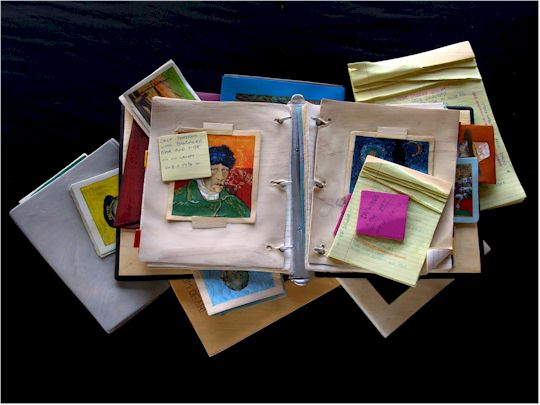Work on Monday: "Van Gogh" by Randall Rosenthal

Today, Work on Monday examines the beguiling wood sculpture of East Hampton artist Randall Rosenthal. The artist has an uncanny ability to recreate objects from everyday life out of single blocks of wood. His 2005 piece, “Van Gogh” is a particularly stunning accomplishment and demonstrates well Rosenthal’s ability to make the viewer appreciate the seemingly mundane in a new way.
Work on Monday is a weekly look at one piece of art related to the East End, usually by a Hamptons or North Fork artist, living or dead, created in any kind of media. Join the conversation by posting your thoughts in the comments below and email suggestions for a future Work on Monday here.
Van Gogh
Randall Rosenthal (b. 1947, East Hampton)
Acrylic and ink on one block of Vermont White Pine
18 x 31 x 4 inches, 2005
In “Van Gogh,” Rosenthal recreates a three-ring notebook/binder lying atop a stack of various paper objects, including a yellow legal pad covered in notes, books and a number of postcards featuring paintings by Vincent Van Gogh. Two of these are taped inside the book and others peek out from its curling, aged pages.
Rosenthal’s stacking of paper and his addition of things like the bright pink pad of Post-it notes and the smaller legal pad with highlighted words goes a long way to show the depth of his talent. This artist can sell dozens of pieces each year based on their technical mastery alone, but Rosenthal reaches the realm of fine art by highlighting the seemingly mundane and making it important. The concept harkens back to Marcel Duchamp‘s Dada readymades, but Rosenthal‘s time and labor adds greatly to the importance of his creations.
He seduces the viewer to look more closely at average objects—a well-used legal pad, for example—and see how he accomplishes making such exceptional recreations. But in doing so, Rosenthal prompts one to really look and appreciate all the nuance and detail of the ordinary, then suddenly realize that these things, all things around us, are actually quite extraordinary.
It is only after considering the difficulty of remaking it, that the object becomes magical, individual and so incredibly personal. Each page and pad carries notations and marks of its journey through life, like unique fingerprints of experience that set it apart, even from previously-identical objects.
The most successful of Rosenthal’s work, like “Van Gogh,” demonstrate the uniqueness and beauty of objects while revealing portraits of the people who own them. From here, narratives form about both object and owner, twisting and turning as the viewer charges willingly ahead, enchanted by two lives, two stories and the paths they share.
Randy Rosenthal’s work, including “Van Gogh,” is available at Bernarducci Meisel Gallery in Manhattan, among others. Visit bernarduccimeisel.com or randallrosenthal.com for more.










